1997 CHEVROLET CAVALIER engine coolant
[x] Cancel search: engine coolantPage 10 of 388
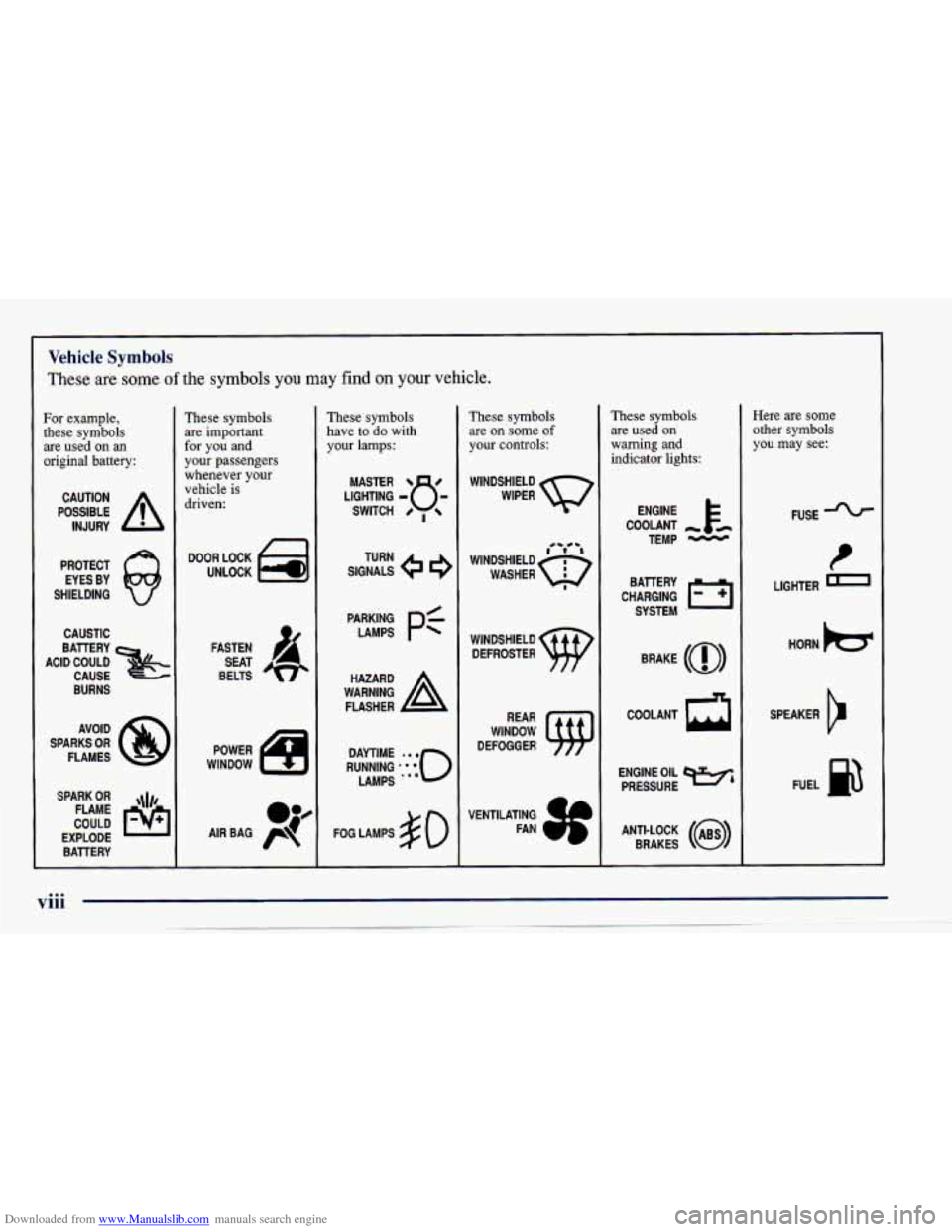
Downloaded from www.Manualslib.com manuals search engine Vehicle Symbols
These are some of the symbols you may find on your vehicle.
For example,
these symbols
are used on an
original battery:
POSSIBLE A
CAUTION
INJURY
PROTECT EYES
BY
SHIELDING Q
CAUSTIC
BURNS AVOID
SPARKS
OR
FLAMES
SPARK
OR ,\I/,
COULD FLAME
EXPLODE BATTERY
These symbols are important
for you
and
your passengers
whenever your
vehicle
is
driven:
n
UNLOCK la
FASTEN
SEAT
BELTS
POWER
WINDOW
0p
AIR BAG p
These symbols
have to do with
your lamps:
SIGNALS e
TURN
FOG LAMPS # 0
These symbols are
on some of
your controls:
WINDSHIELD
DEFROSTER
WINDOW
DEFOGGER
These symbols are used
on
warning and
indicator lights:
ENGINE k
COOLANT - th
TEMP -
CHARGING I-1
BATTERY
SYSTEM
'
BRAKE (a)
R
COOLANT
ENGINE OIL
e,
PRESSURE
ANTI-LOCK
(e)
BRAKES
Here are some
other symbols
you may see:
FUSE
t
LIGHTER
HORN
)a(
SPEAKER
b
FUEL p3
Page 59 of 388
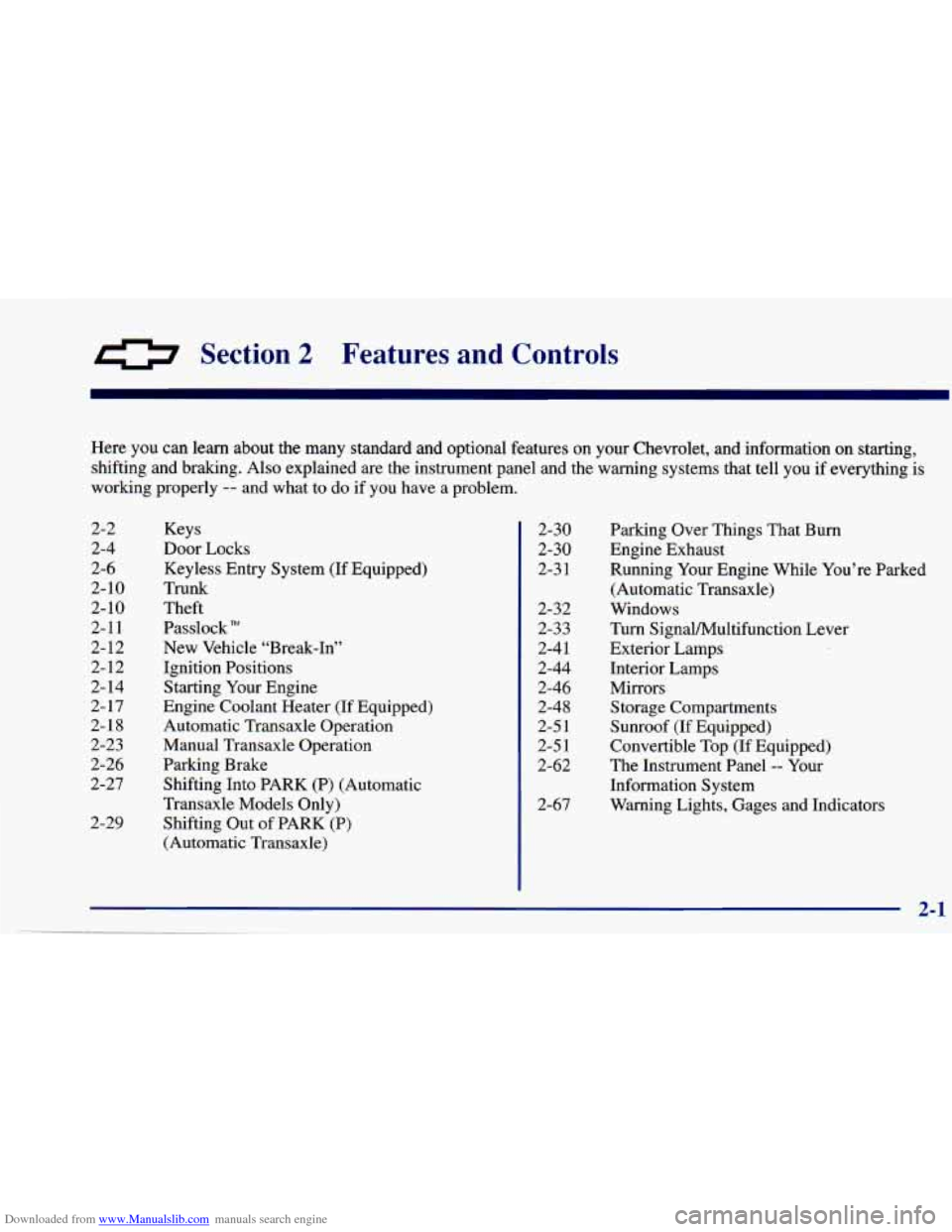
Downloaded from www.Manualslib.com manuals search engine 0 Section 2 Features and Controls
2-2
2-4
2-6
2-10 2-10
2-1 1
2-12
2-12
2- 14
2-
17
2-18
2-23
2-26
2-27
2-29 2-30
2-30
2-3 1
2-32 2-33
2-4
1
2-44
2-46
2-48
2-5 1
2-5 1
2-62
2-67 Parking Over Things That
Bum
Engine Exhaust
Running Your Engine While You’re Parked
(Automatic Transaxle)
Windows
Turn Signalhlultifunction Lever
Exterior Lamps
Interior Lamps
Mirrors Storage Compartments
Sunroof
(If Equipped)
Convertible Top
(If Equipped)
The Instrument Panel
-- Your
Information System
Warning Lights, Gages and Indicators
Here
you can learn about the many standard and optional features on your Chevrolet, and information
on starting,
shifting and braking. Also explained are the instrument panel and the warning systems that tell you
if everything is
working properly
-- and what to do if you have a problem.
Keys
Door Locks
Keyless Entry System (If Equipped)
Trunk
Theft
Passlock
New Vehicle “Break-In”
Ignition Positions Starting Your Engine
Engine Coolant Heater
(If Equipped)
Automatic Transaxle Operation
Manual Transaxle Operation
Parking Brake
Shifting Into PARK (P) (Automatic
Transaxle Models Only)
Shifting Out
of PARK (P)
(Automatic Transaxle)
2-1
Page 75 of 388
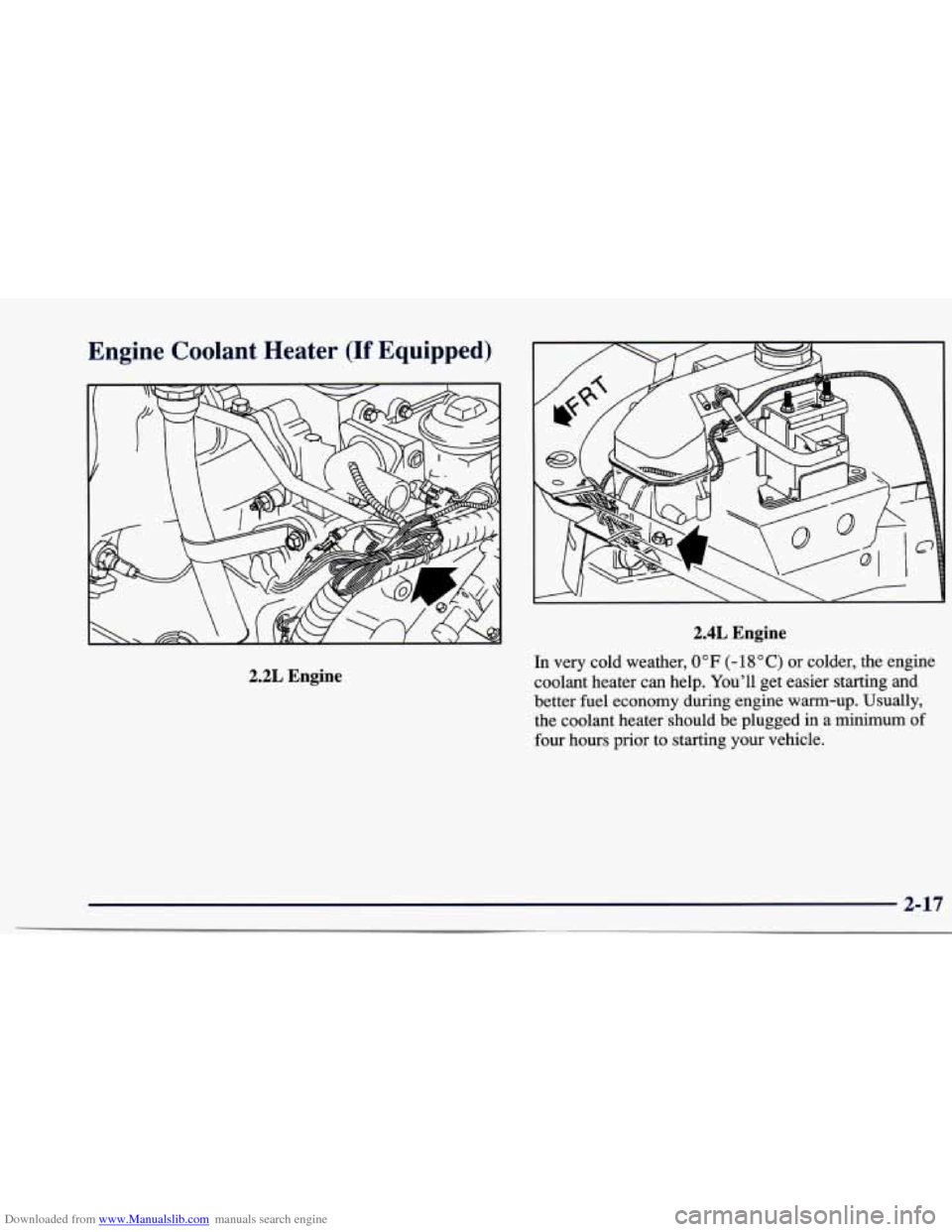
Downloaded from www.Manualslib.com manuals search engine Engine Coolant Heater (If Equipped)
2.4L Engine
2.2L Engine
In very cold weather, 0°F (-18°C) or colder, the engine
coolant heater can help. You'll get easier starting
and
better fuel economy during engine warm-up. Usually,
the coolant heater should be plugged in
a minimum of
four hours prior to starting your vehicle.
2-17
Page 76 of 388
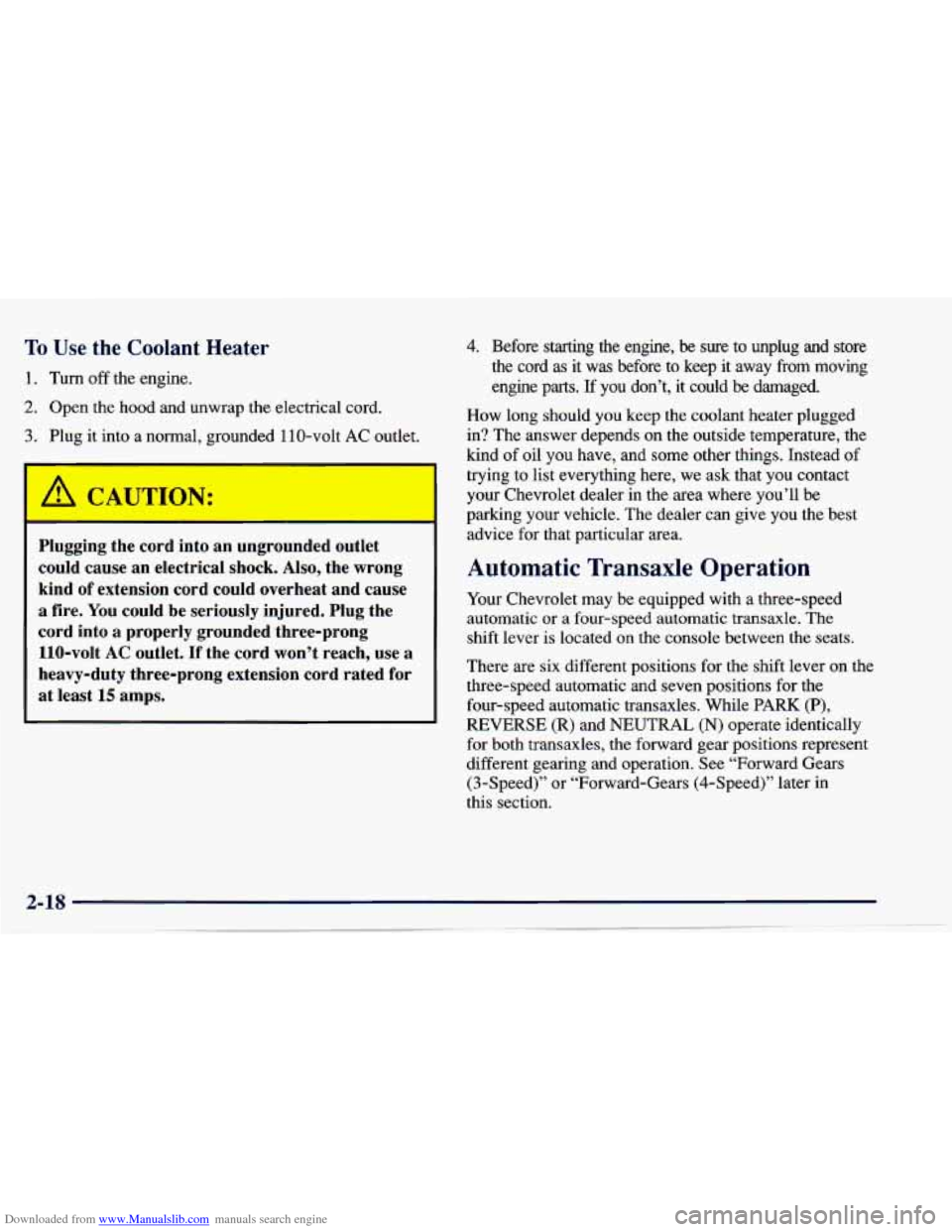
Downloaded from www.Manualslib.com manuals search engine To Use the Coolant Heater
1. Turn off the engine.
2. Open the hood and unwrap the electrical cord.
3. Plug it into a normal, grounded
1 10-volt AC outlet.
I
Plugging the cord into an ungrounded outlet
could cause an electrical shock. Also, the wrong kind
of extension cord could overheat and cause
a fire. You could be seriously injured. Plug the
cord into a properly grounded three-prong
110-volt
AC outlet. If the cord won’t reach, use a
heavy-duty three-prong extension cord rated for
at least
15 amps.
4. Before starting the engine, be sure to unplug and store
the cord
as it was before to keep it away from moving
engine parts.
If you don’t, it could be damaged.
How long should you keep the coolant heater plugged
in? The answer depends on the outside temperature, the
kind of oil you have, and some other things. Instead of trying
to list everything here, we ask that you contact
your Chevrolet dealer in the area where you’ll be
parking your vehicle. The dealer can give you the best
advice for that particular area.
Automatic Transaxle Operation
Your Chevrolet may be equipped with a three-speed
automatic
or a four-speed automatic transaxle. The
shift lever is located on the console between the seats.
There are six different positions for the shift lever on the
three-speed automatic and seven positions for the
four-speed automatic transaxles. While PARK
(P),
REVERSE (R) and NEUTRAL (N) operate identically
for both transaxles, the forward gear positions represent
different gearing and operation.
See “Forward Gears
(3-Speed)” or “Forward-Gears (4-Speed)” later in
this section.
Page 130 of 388
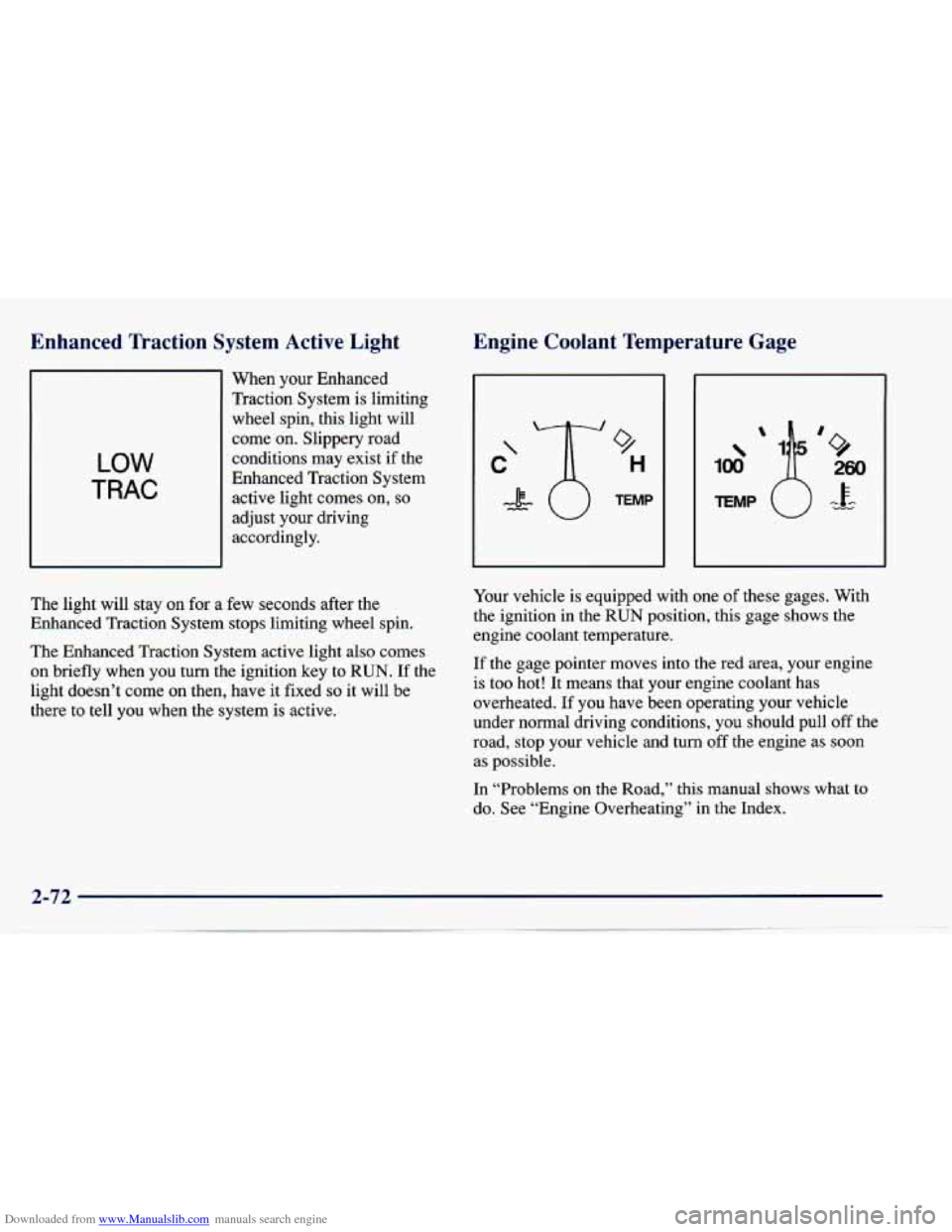
Downloaded from www.Manualslib.com manuals search engine Enhanced Traction System Active Light
LOW
TRAC
When your Enhanced
Traction System is limiting
wheel spin, this light will
come on. Slippery road
conditions may exist if the
Enhanced Traction System active light comes on,
so
adjust your driving
accordingly.
The light will stay
on for a few seconds after the
Enhanced Traction System stops limiting wheel spin.
The Enhanced Traction System active light also comes
on briefly when you turn the ignition key to
RUN. If the
light doesn’t come
on then, have it fixed so it will be
there
to tell you when the system is active.
Engine Coolant Temperature Gage
9
H
TEMP
Your vehicle is equipped with one of these gages. With
the ignition in the
RUN position, this gage shows the
engine coolant temperature.
If the gage pointer moves into the red
area, your engine
is too hot! It means that your engine coolant has
overheated.
If you have been operating your vehicle
under normal driving conditions,
you should pull off the
road, stop your vehicle and turn off the engine as soon
as possible.
In “Problems on the Road,” this manual shows what to
do. See “Engine Overheating” in the Index.
Page 131 of 388
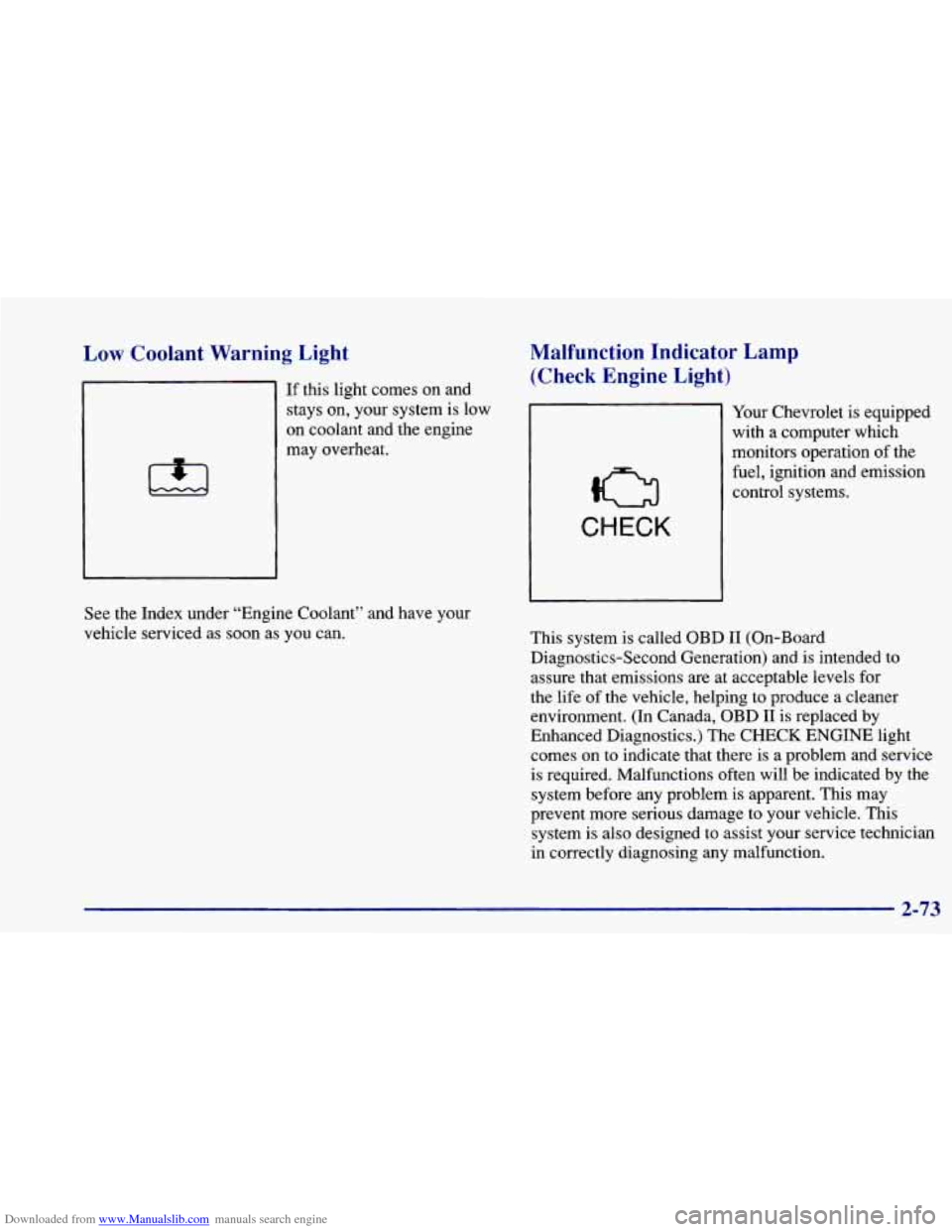
Downloaded from www.Manualslib.com manuals search engine Low Coolant Warning Light
If this light comes on and
stays on, your system is low
on coolant and the engine
may overheat.
Malfunction Indicator Lamp
(Check Engine Light)
CHECK
Your Chevrolet is equipped
with a computer which
monitors operation of the
fuel, ignition
and emission
control systems.
See the Index under “Engine Coolant’’ and have your
vehicle serviced as soon as
you can.
This system is called OBD I1 (On-Board
Diagnostics-Second Generation) and is intended to
assure that emissions are at acceptable levels for
the life of
the vehicle, helping to produce a cleaner
environment. (In Canada,
OBD I1 is replaced by
Enhanced Diagnostics.) The CHECK ENGINE light
comes on to indicate that there
is a problem and service
is required, Malfunctions often will be indicated by the
system before any problem is apparent. This may
prevent more serious damage to your vehicle. This
system is also designed to assist your service technician
in correctly diagnosing any malfunction.
2-73
Page 141 of 388
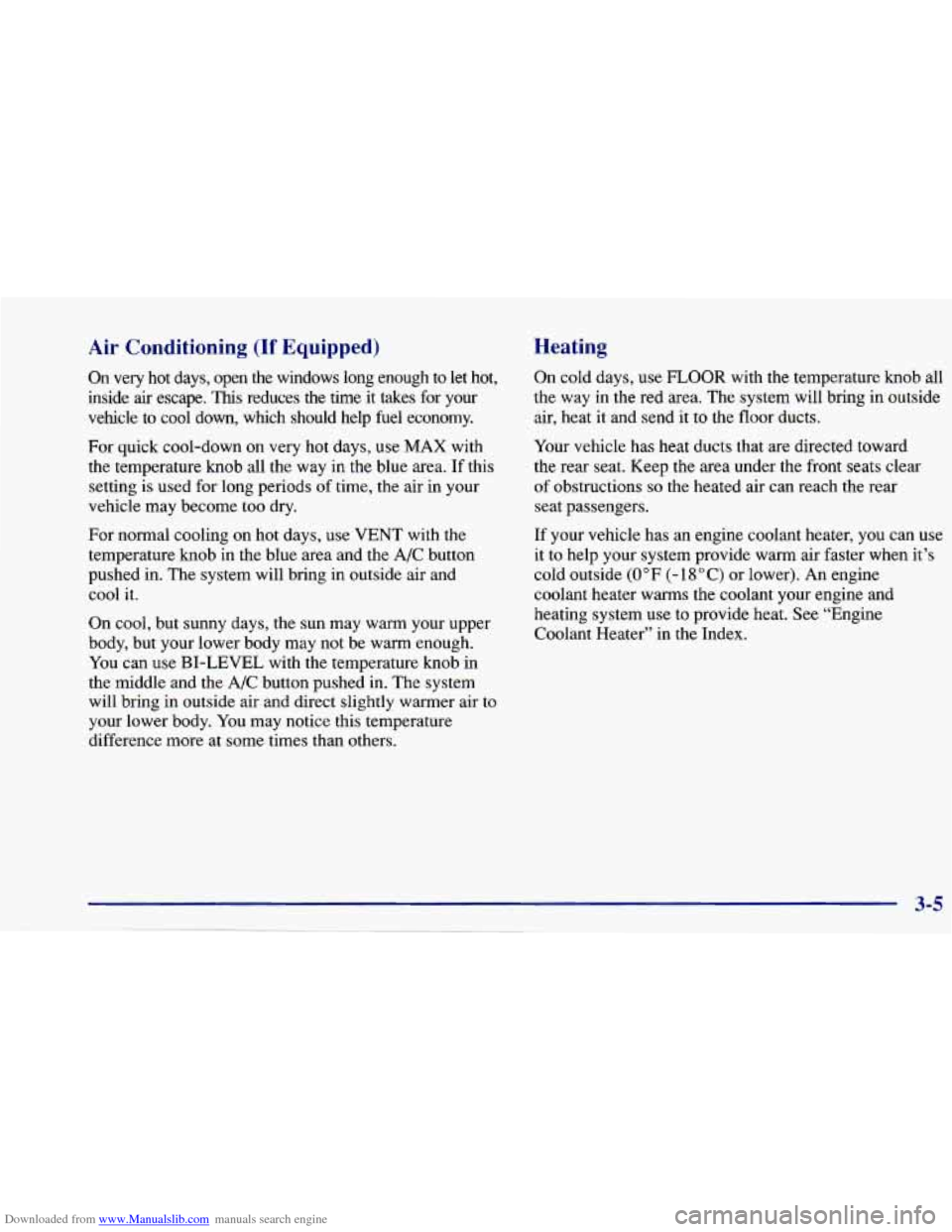
Downloaded from www.Manualslib.com manuals search engine Air Conditioning (If Equipped)
On very hot days, open the windows long enough to let hot,
inside
air escape. This reduces the time it takes for your
vehicle to cool down, which should help fuel economy.
For quick cool-down on very hot days, use
MAX with
the temperature knob all the way in the blue area.
If this
setting is used for long periods
of time, the air in your
vehicle may become too dry.
For normal cooling on hot days, use
VENT with the
temperature knob in the blue area and the
A/C button
pushed in. The system will bring in outside air and
cool it.
On cool, but sunny days, the sun may warm your upper
body, but your lower body may not be warm enough.
You can use
BI-LEVEL with the temperature knob in
the middle and the A/C button pushed
in. The system
will bring
in outside air and direct slightly warmer air to
your lower body. You may notice this temperature
difference more at some times than others.
Heating
On cold days, use FLOOR with the temperature knob all
the way in the red area. The system will bring in outside
air, heat it and send it
to the floor ducts.
Your vehicle has heat ducts that are directed toward
the rear seat. Keep the area under the front seats clear
of obstructions
so the heated air can reach the rear
seat passengers.
If your vehicle has an engine coolant heater, you can
use
it to help your system provide warm air faster when it’s
cold outside
(0°F (-18°C) or lower). An engine
coolant heater warms the coolant your engine and
heating system use to provide heat. See “Engine
Coolant Heater” in the Index.
Page 204 of 388
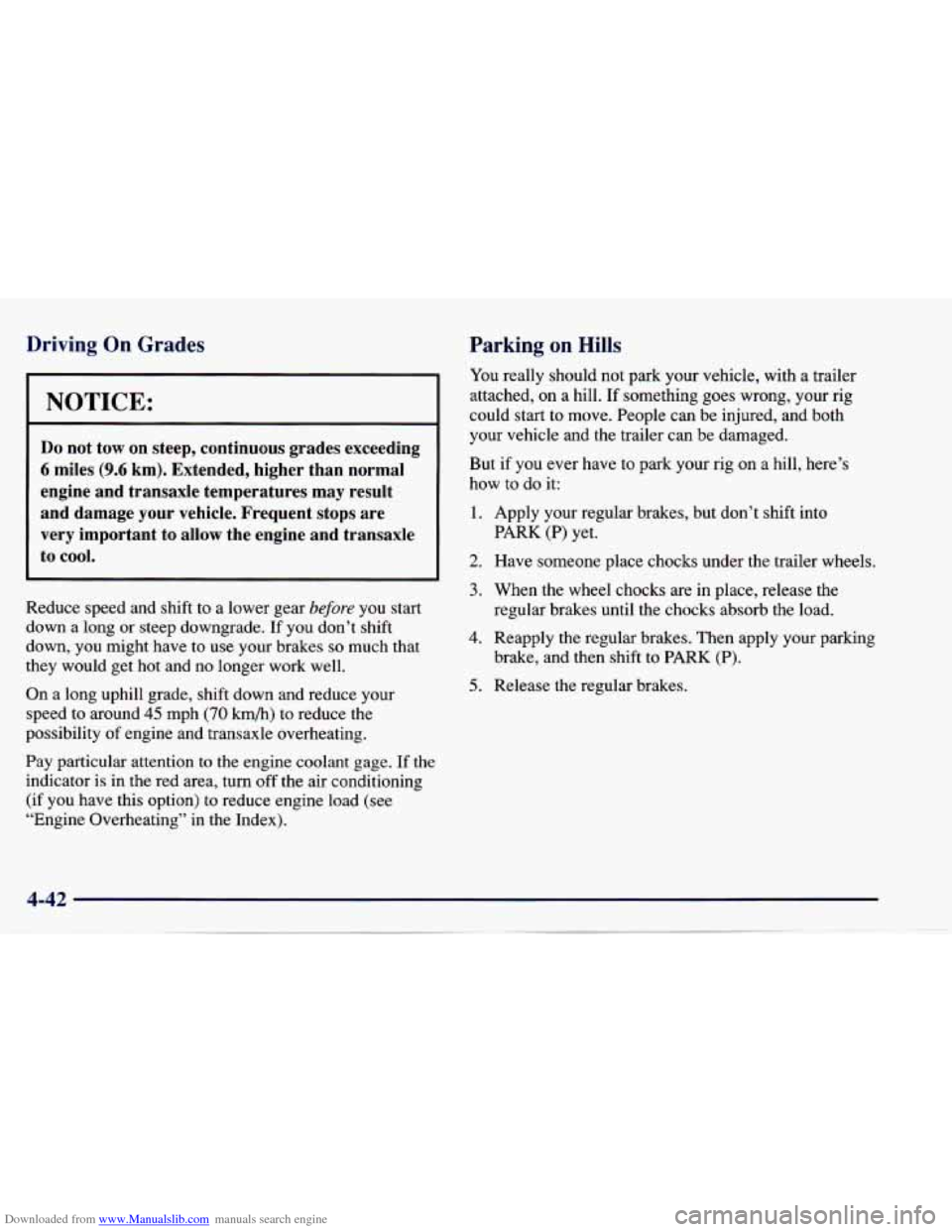
Downloaded from www.Manualslib.com manuals search engine Driving On Grades
NOTICE:
Do not tow on steep, continuous grades exceeding
6 miles (9.6 km). Extended, higher than normal
engine and transaxle temperatures may result
and damage your vehicle. Frequent stops are very important to allow the engine and transaxle
to
cool.
Reduce speed and shift to a lower gear before you start
down a long or steep downgrade. If you don’t shift
down, you might have to use your brakes
so much that
they would get hot and no longer work well.
On a long uphill grade, shift down and reduce your
speed to around
45 mph (70 km/h) to reduce the
possibility of engine and transaxle overheating.
Pay particular attention
to the engine coolant gage. If the
indicator is in the red area, turn off the air conditioning
(if you have this option)
to reduce engine load (see
“Engine Overheating” in the Index).
Parking on Hills
You really should not park your vehicle, with a trailer
attached,
on a hill. If something goes wrong, your rig
could start to move. People can be injured, and both
your vehicle
and the trailer can be damaged.
But
if you ever have to park your rig on a hill, here’s
how
to do it:
1.
2.
3.
4.
5.
Apply your regular brakes, but don’t shift into
PARK (P) yet.
Have someone place chocks under the trailer wheels.
When
the wheel chocks are in place, release the
regular brakes until the chocks absorb the load.
Reapply the regular brakes. Then apply your parking
brake, and then shift
to PARK (P).
Release the regular brakes.